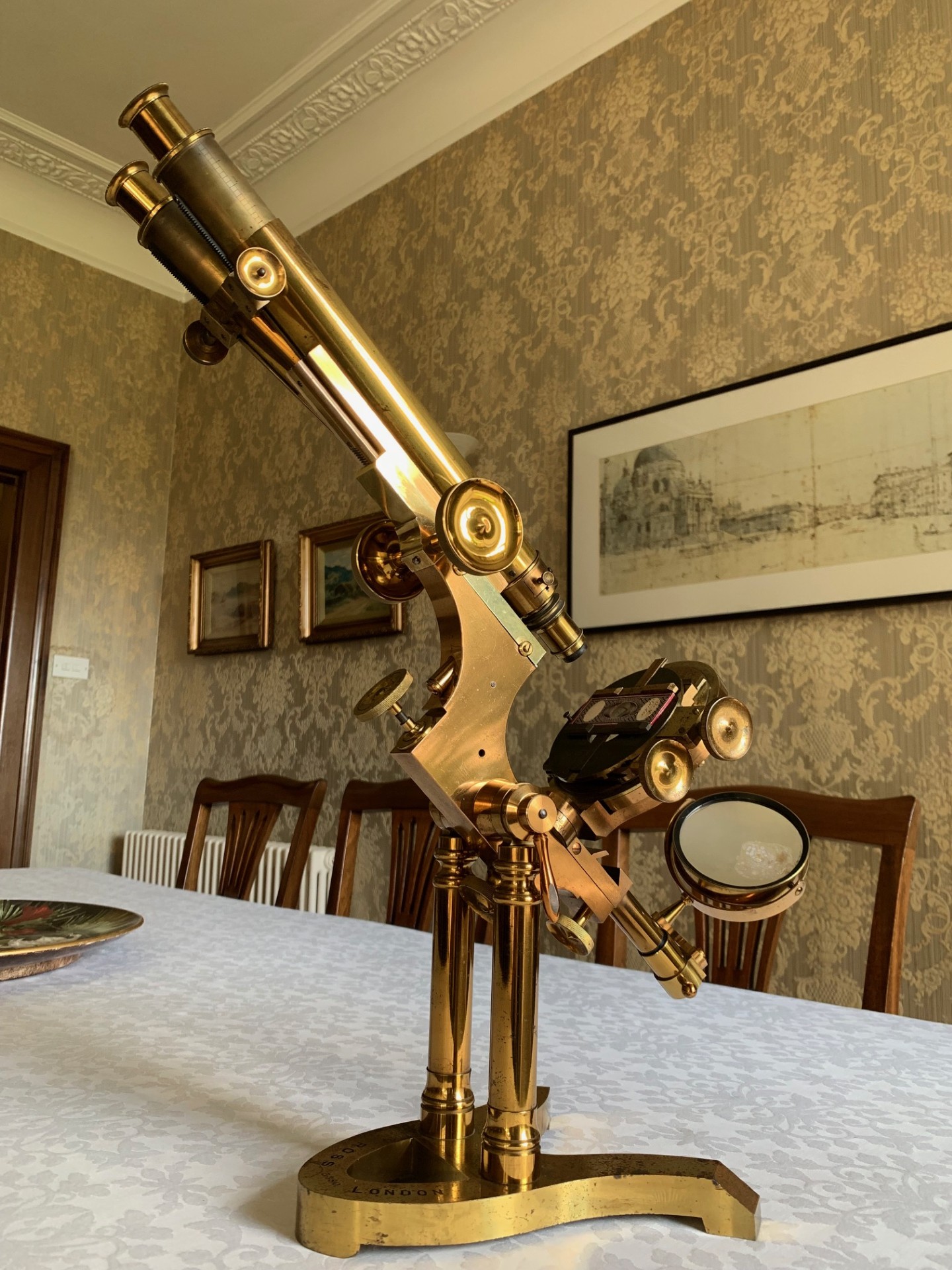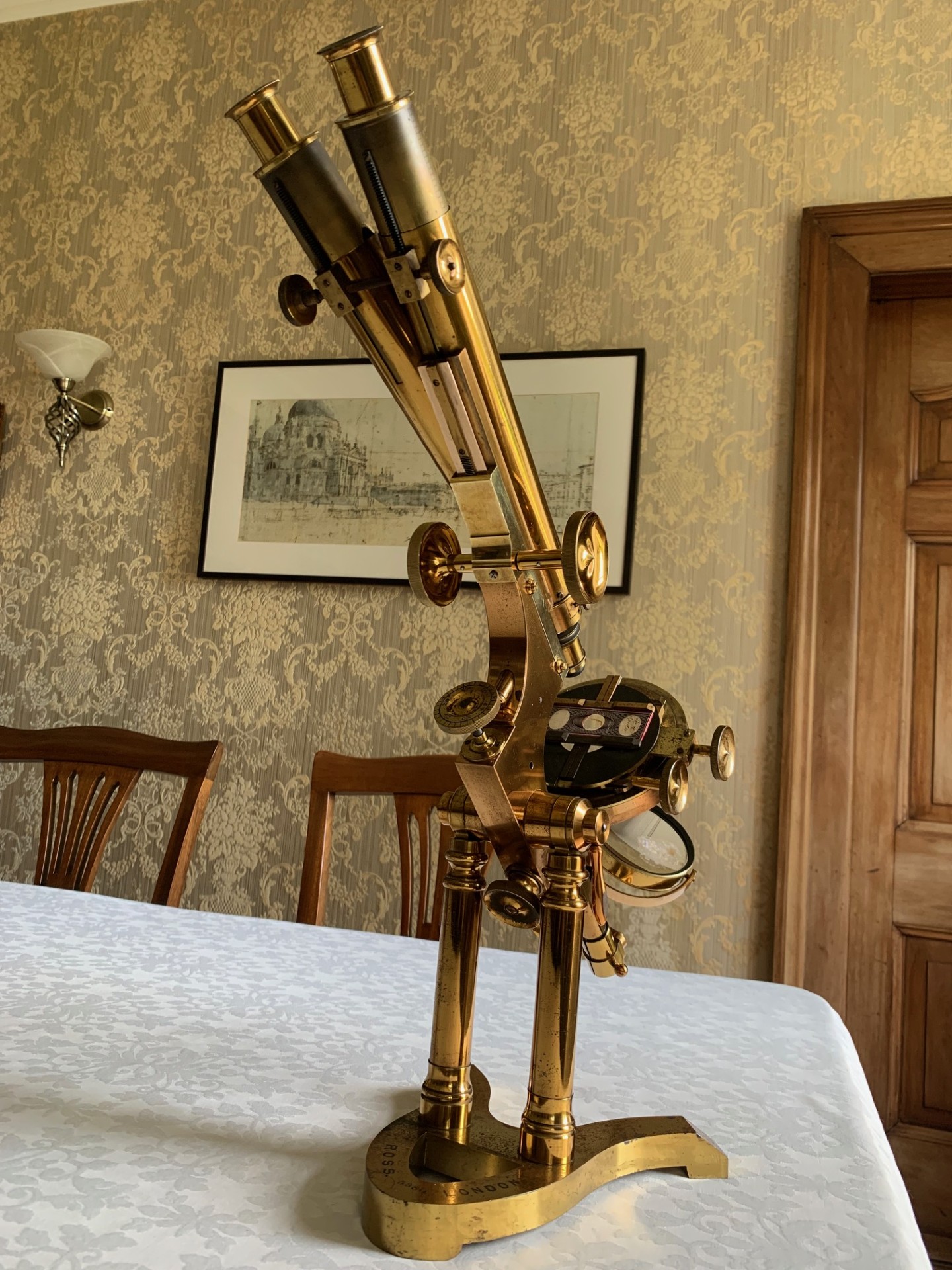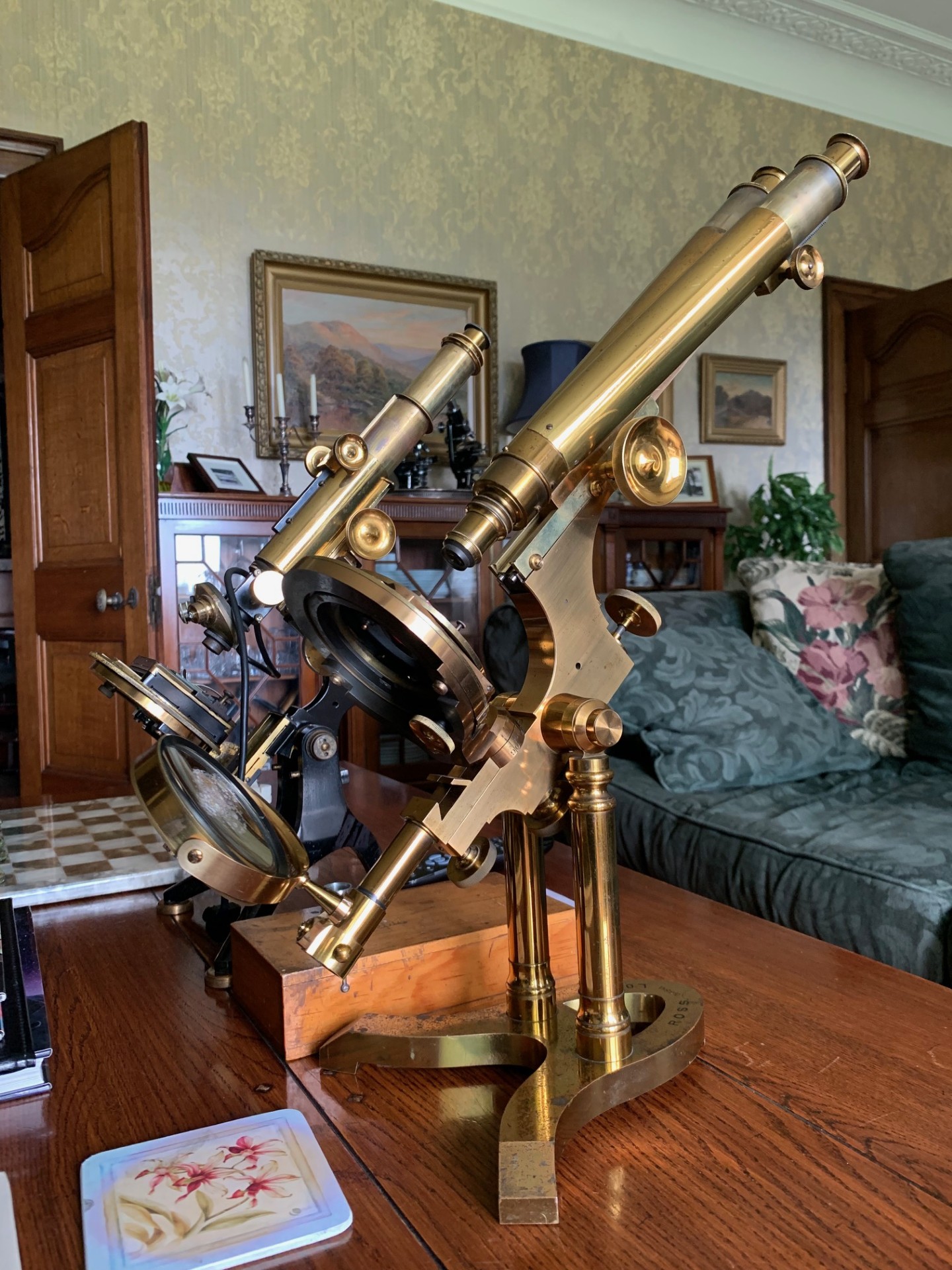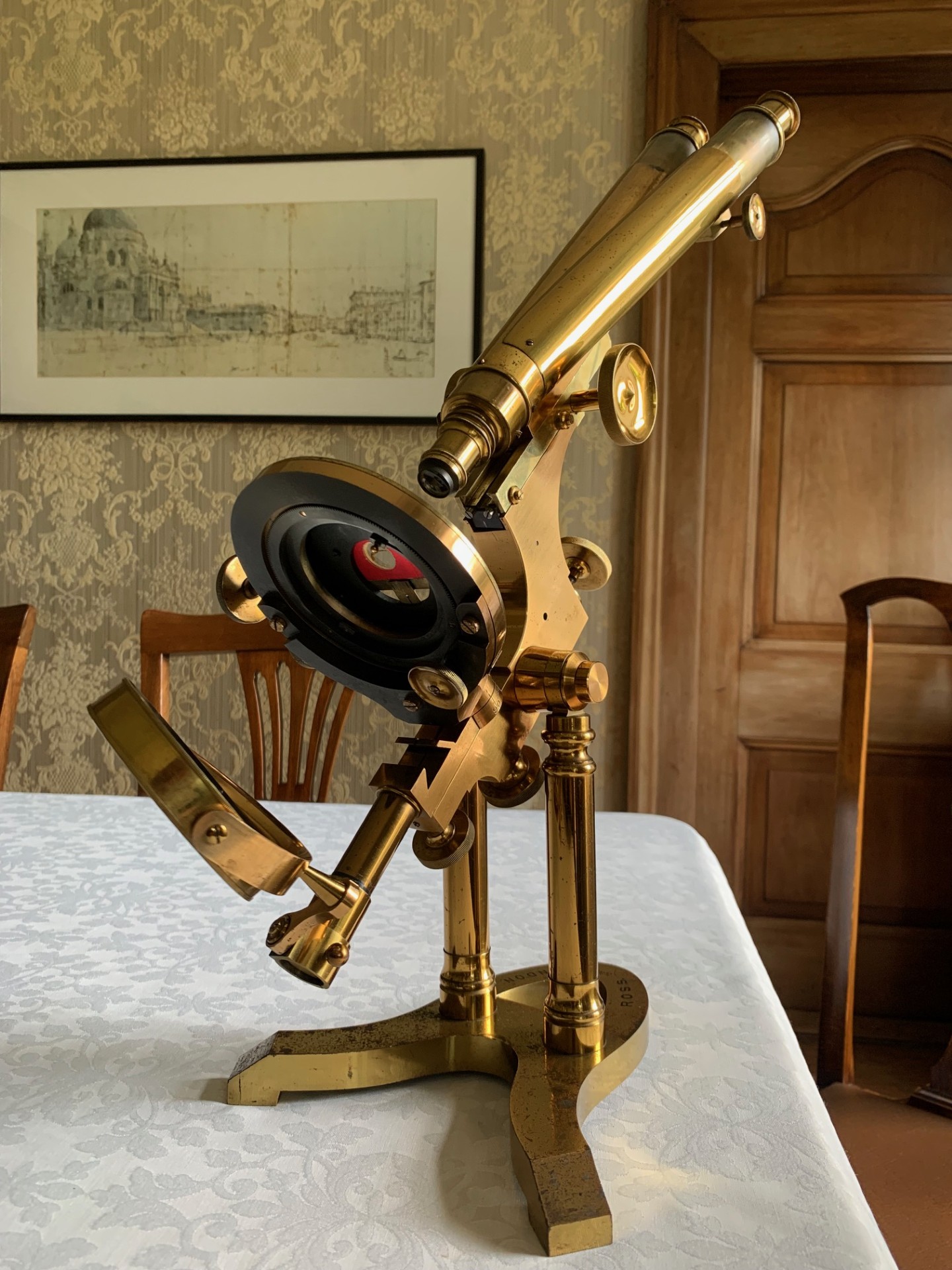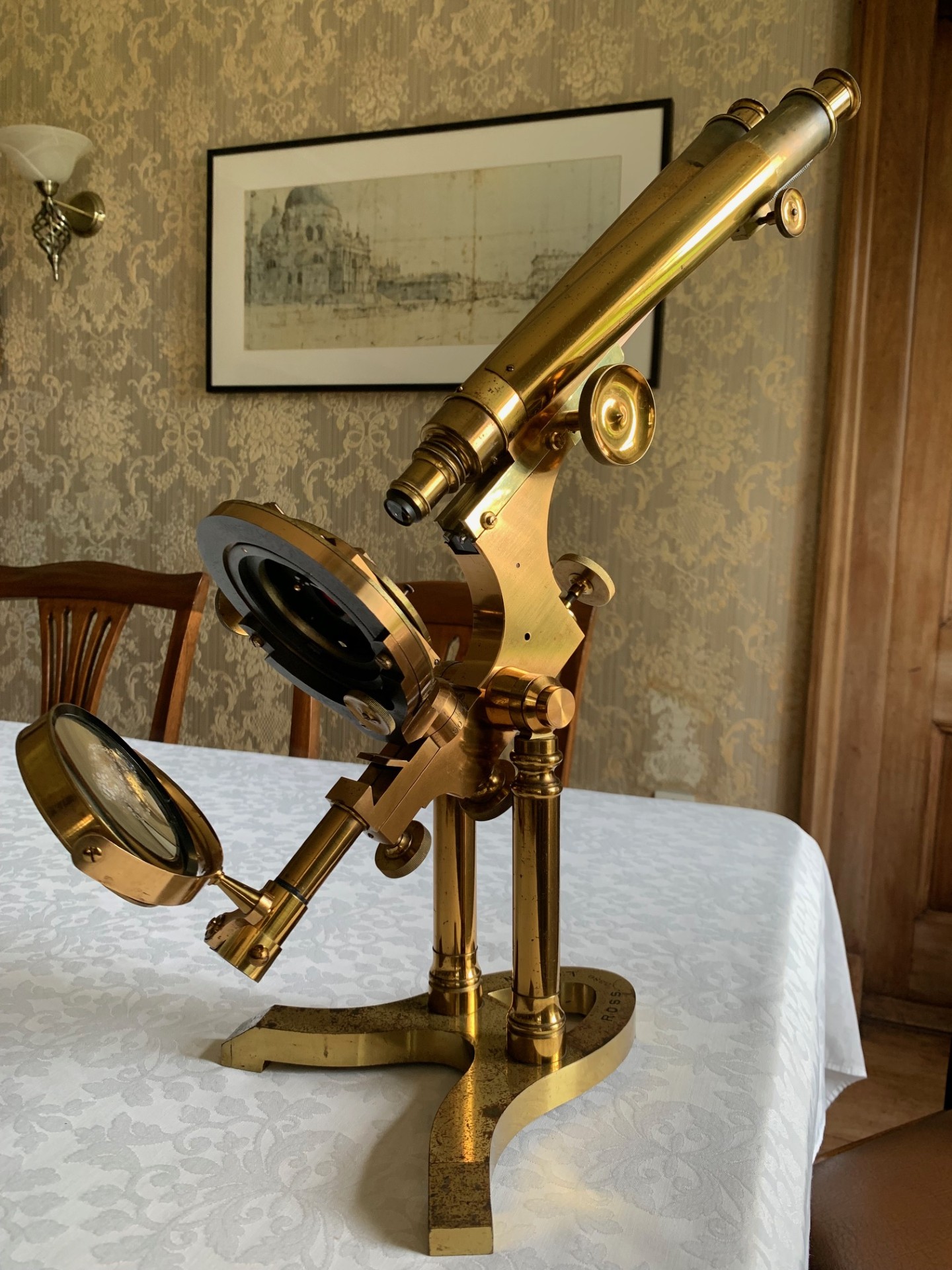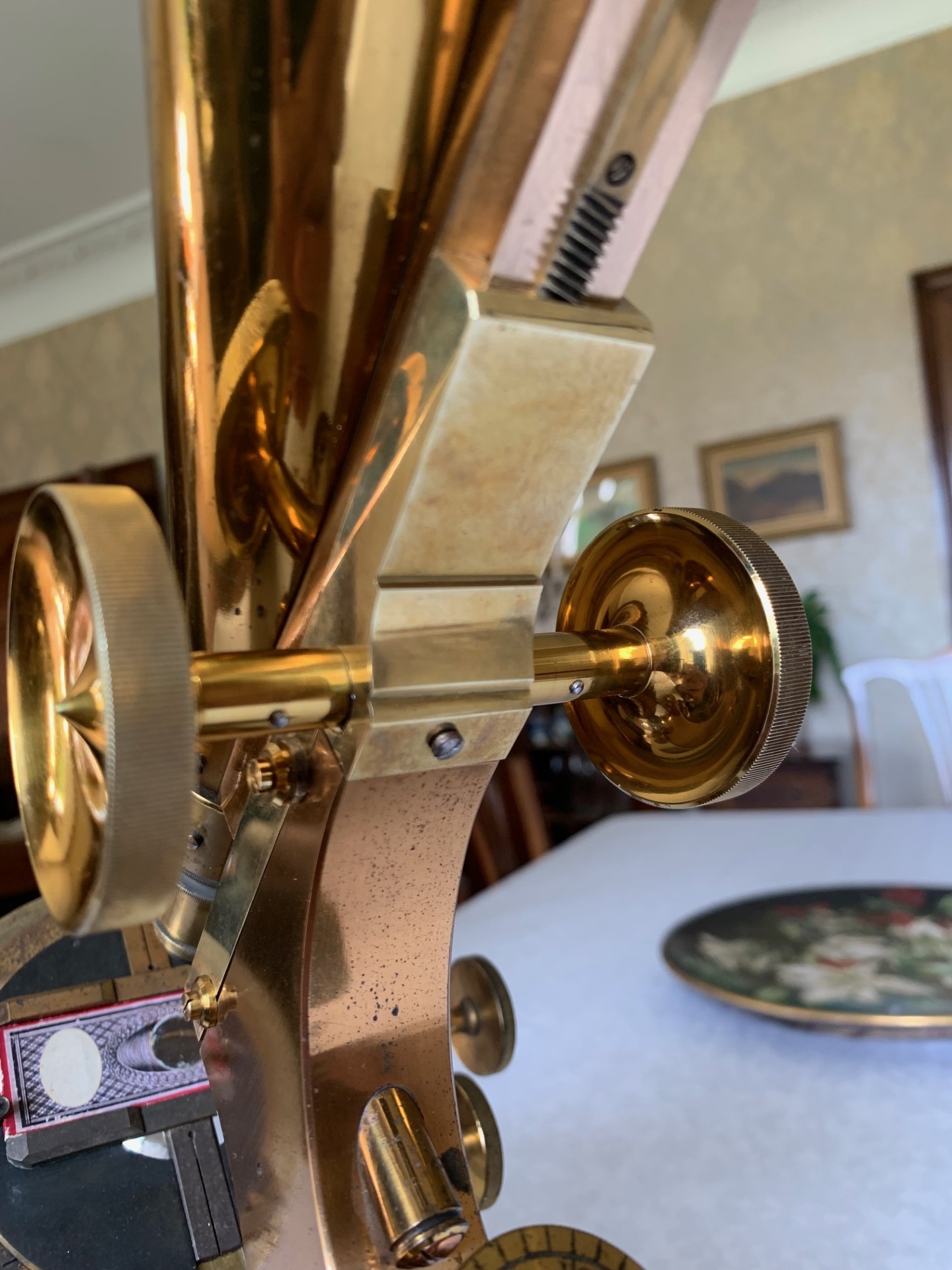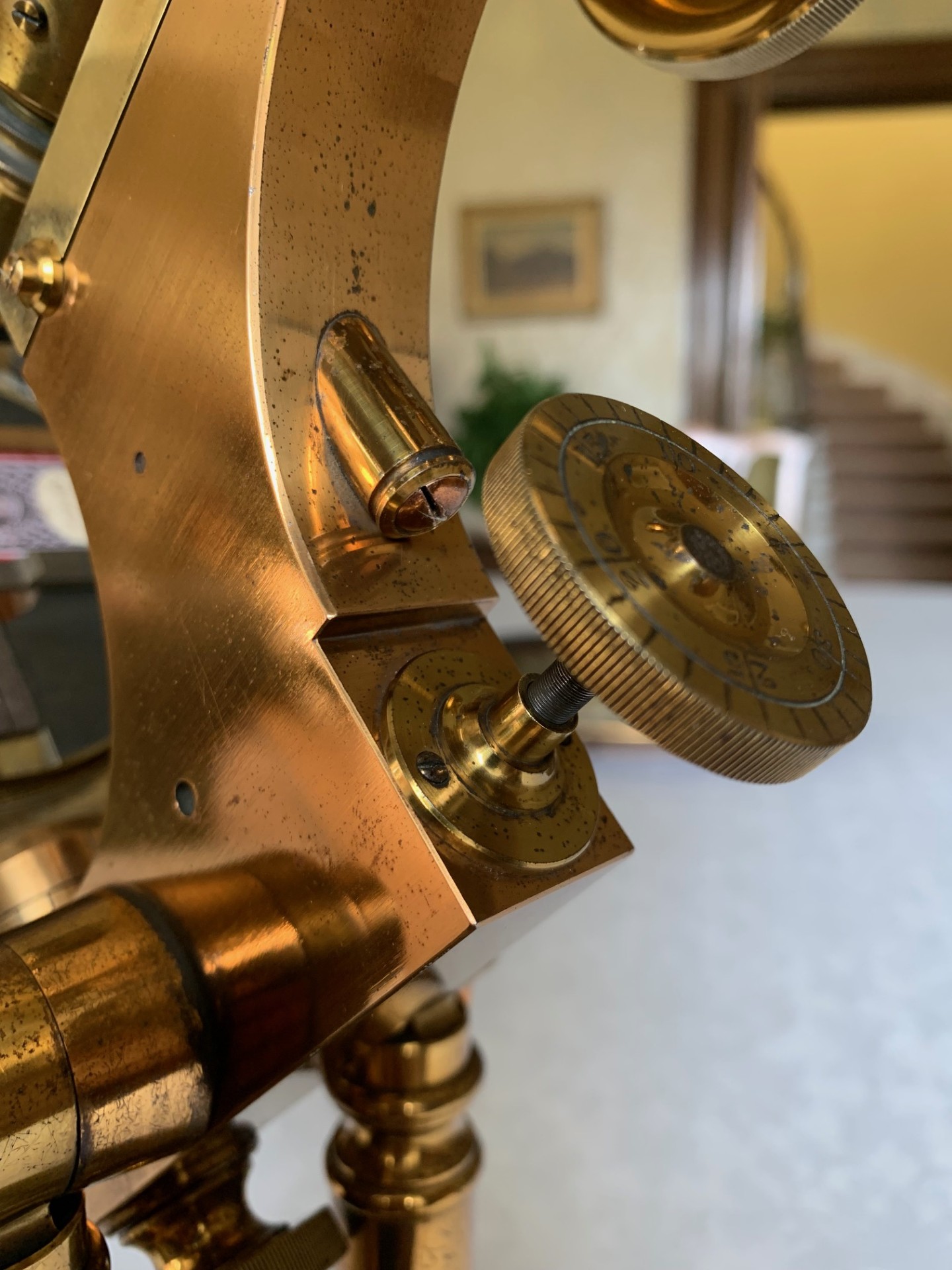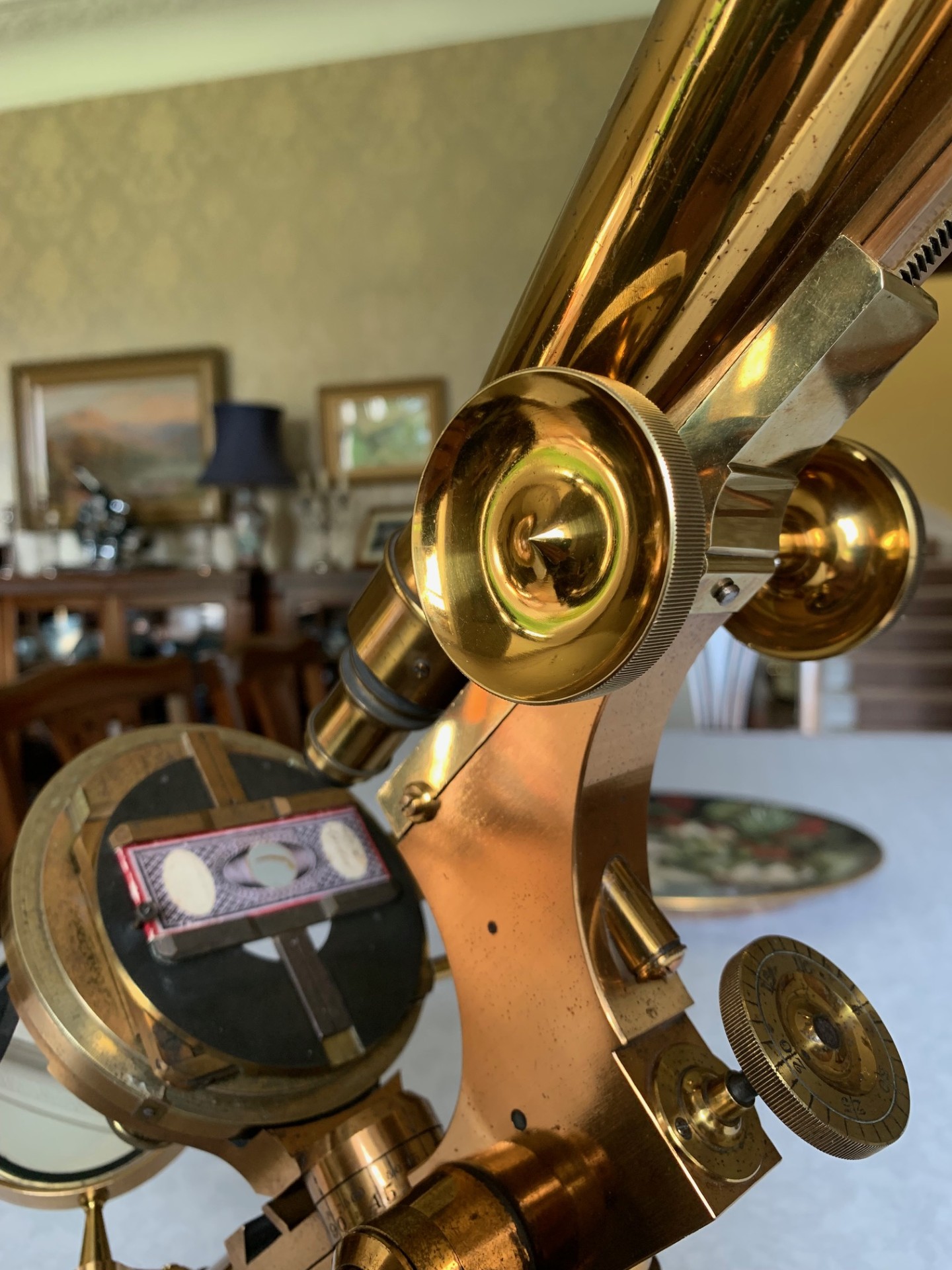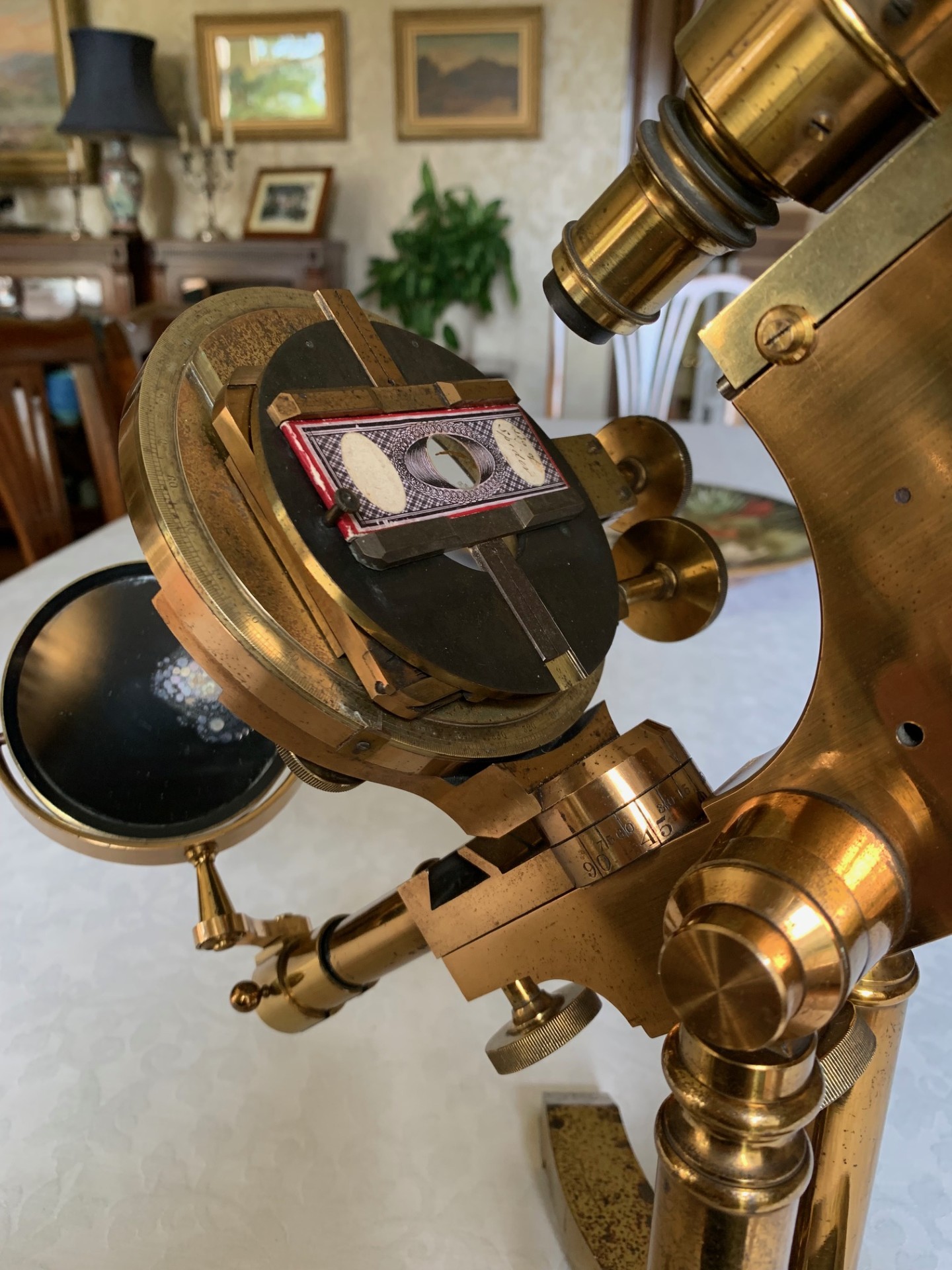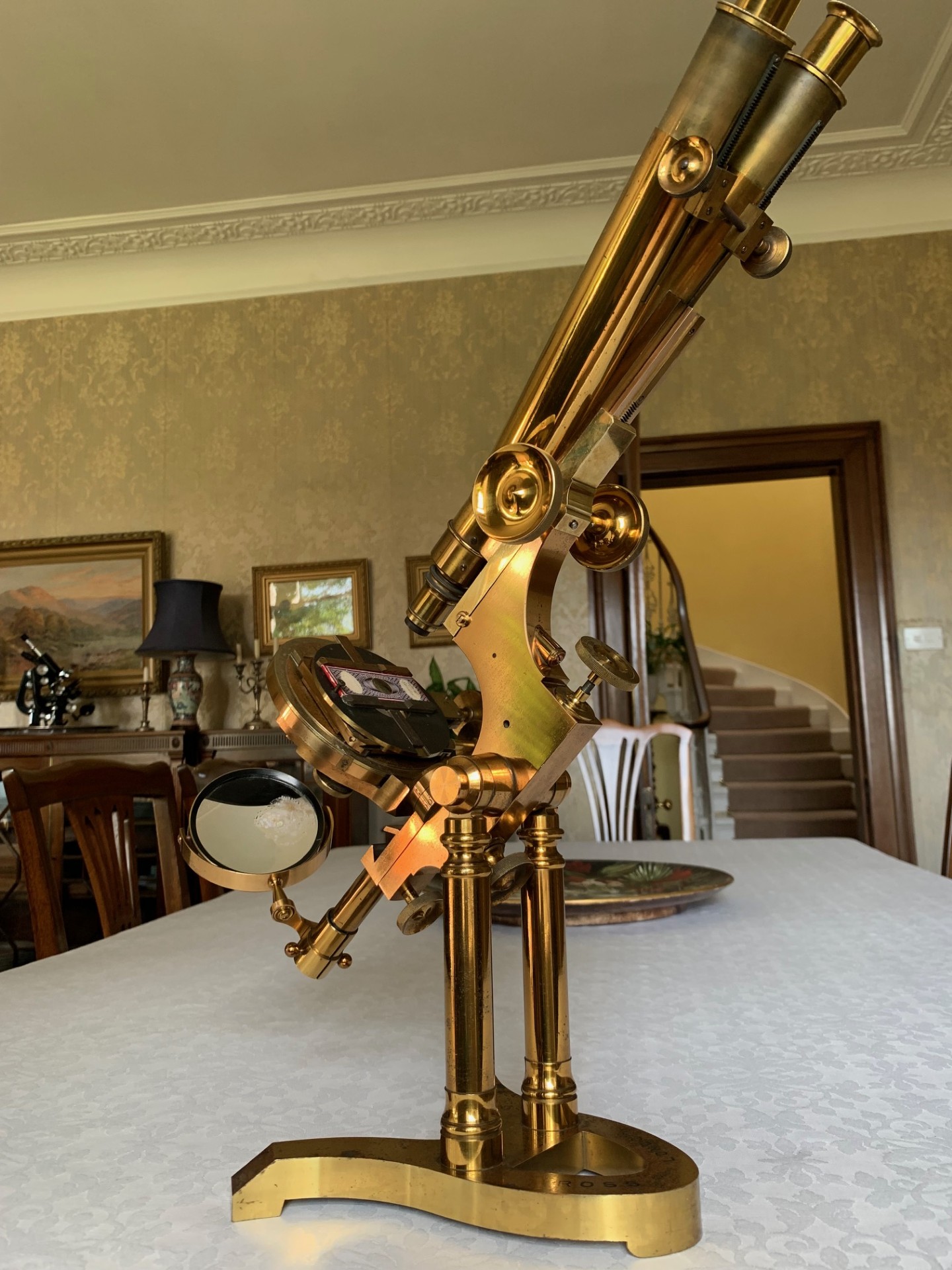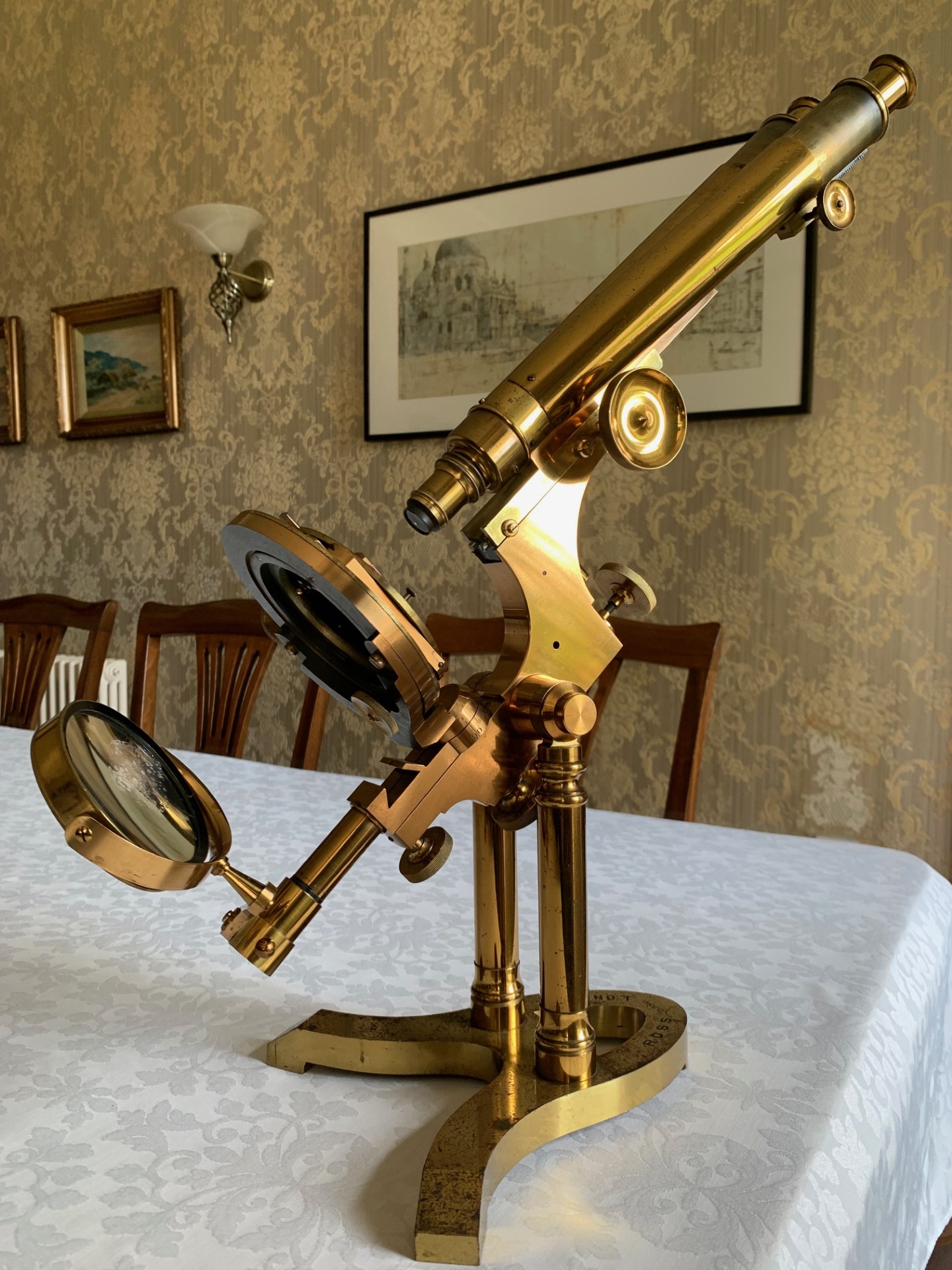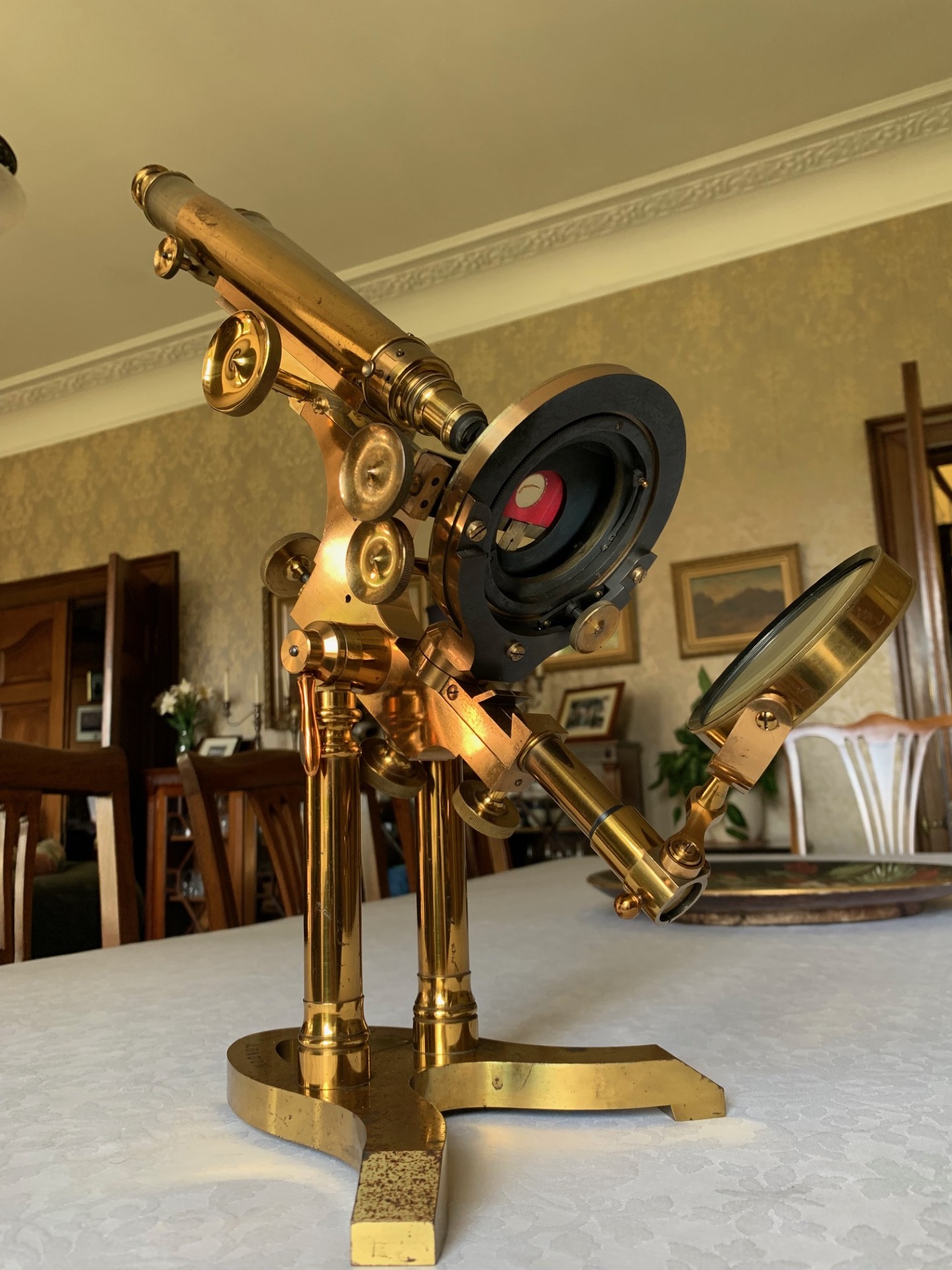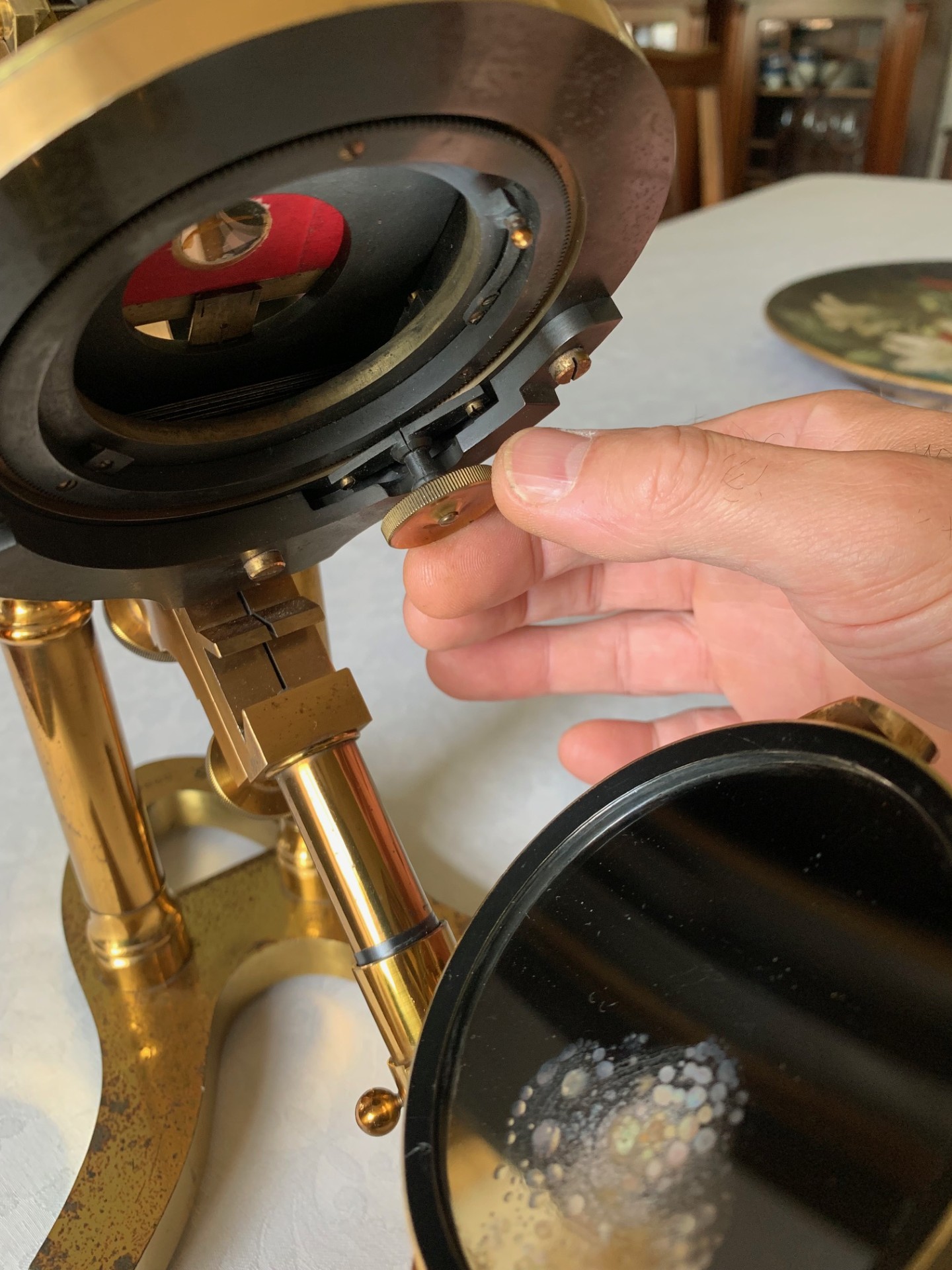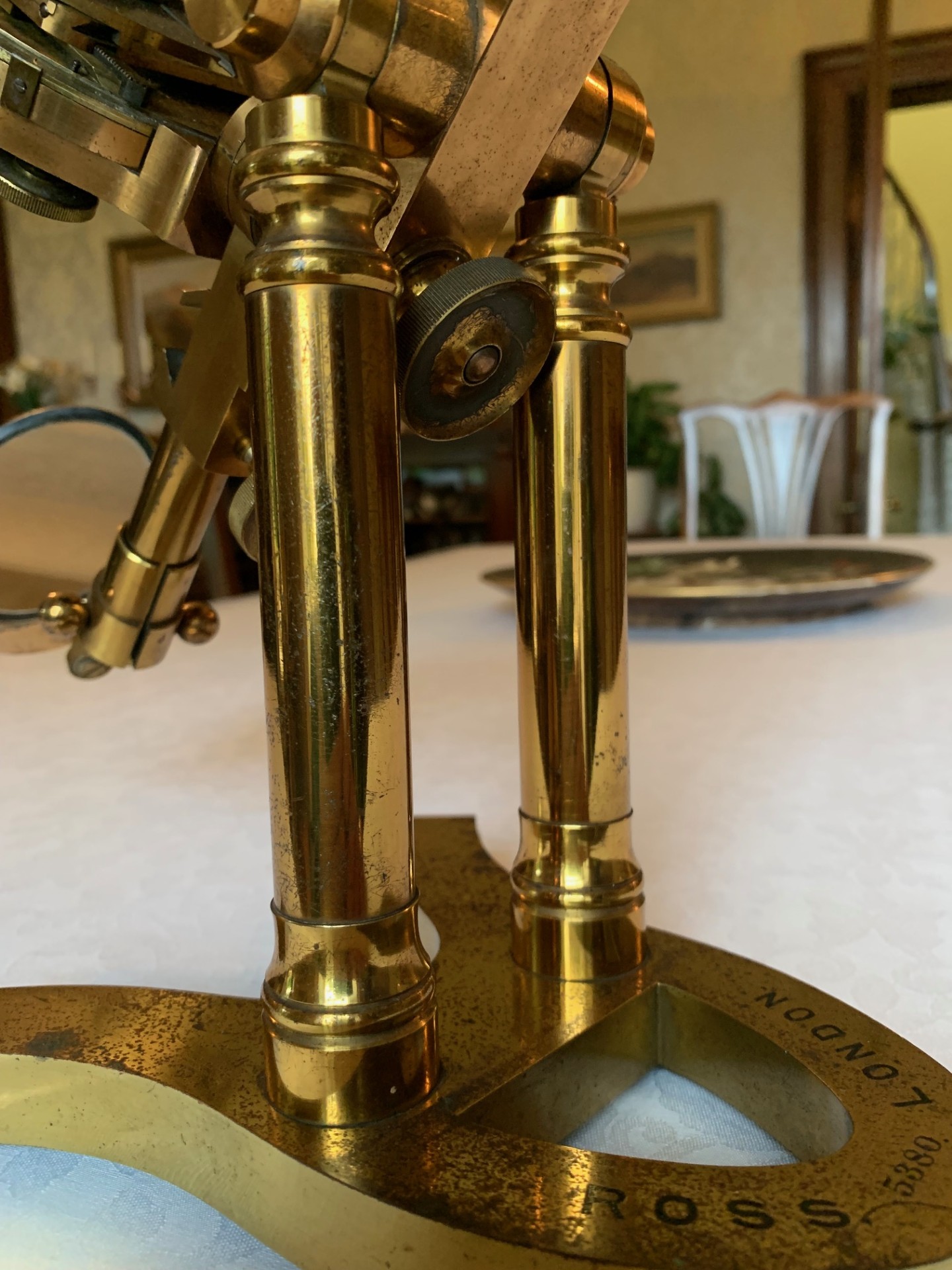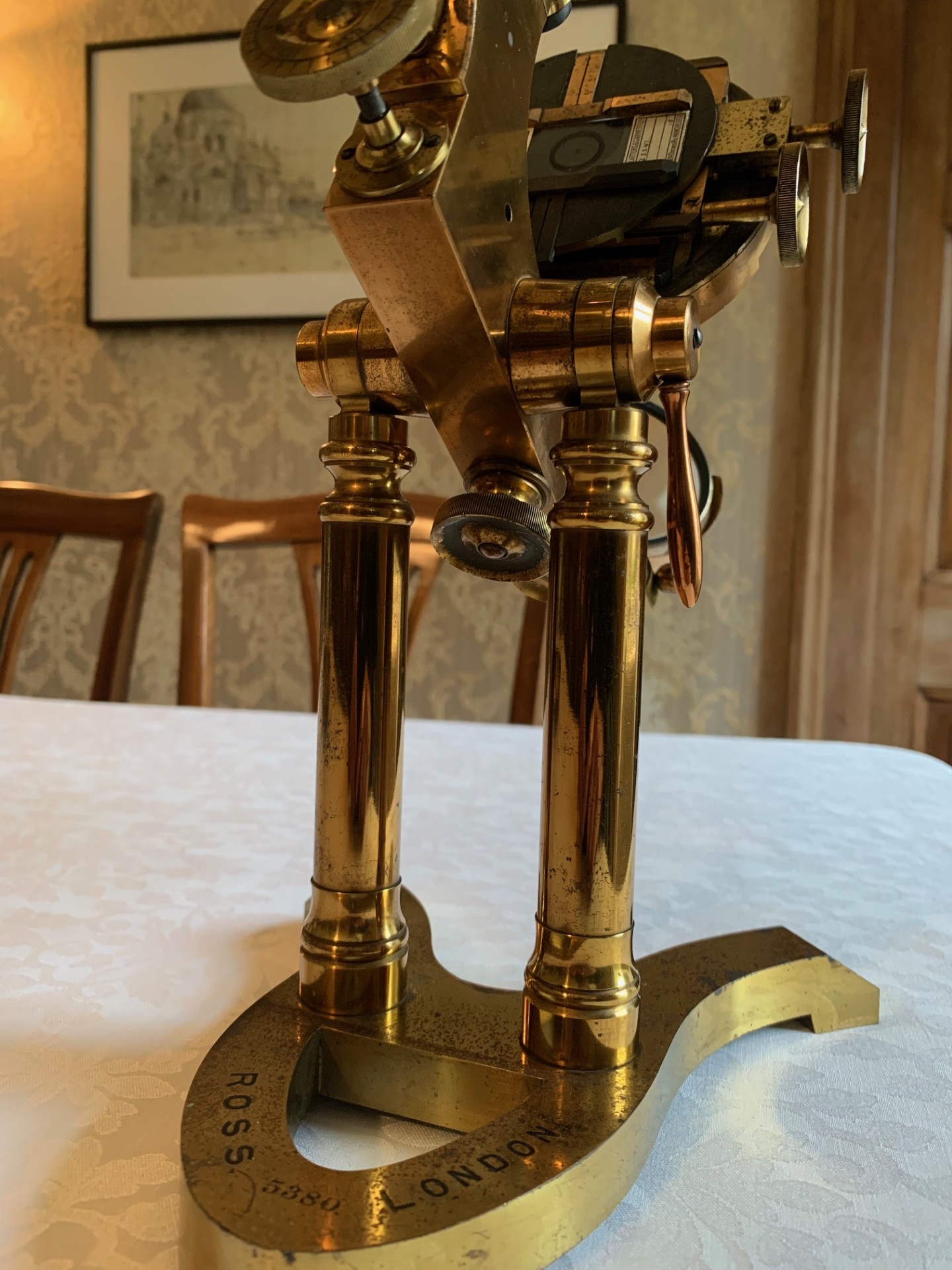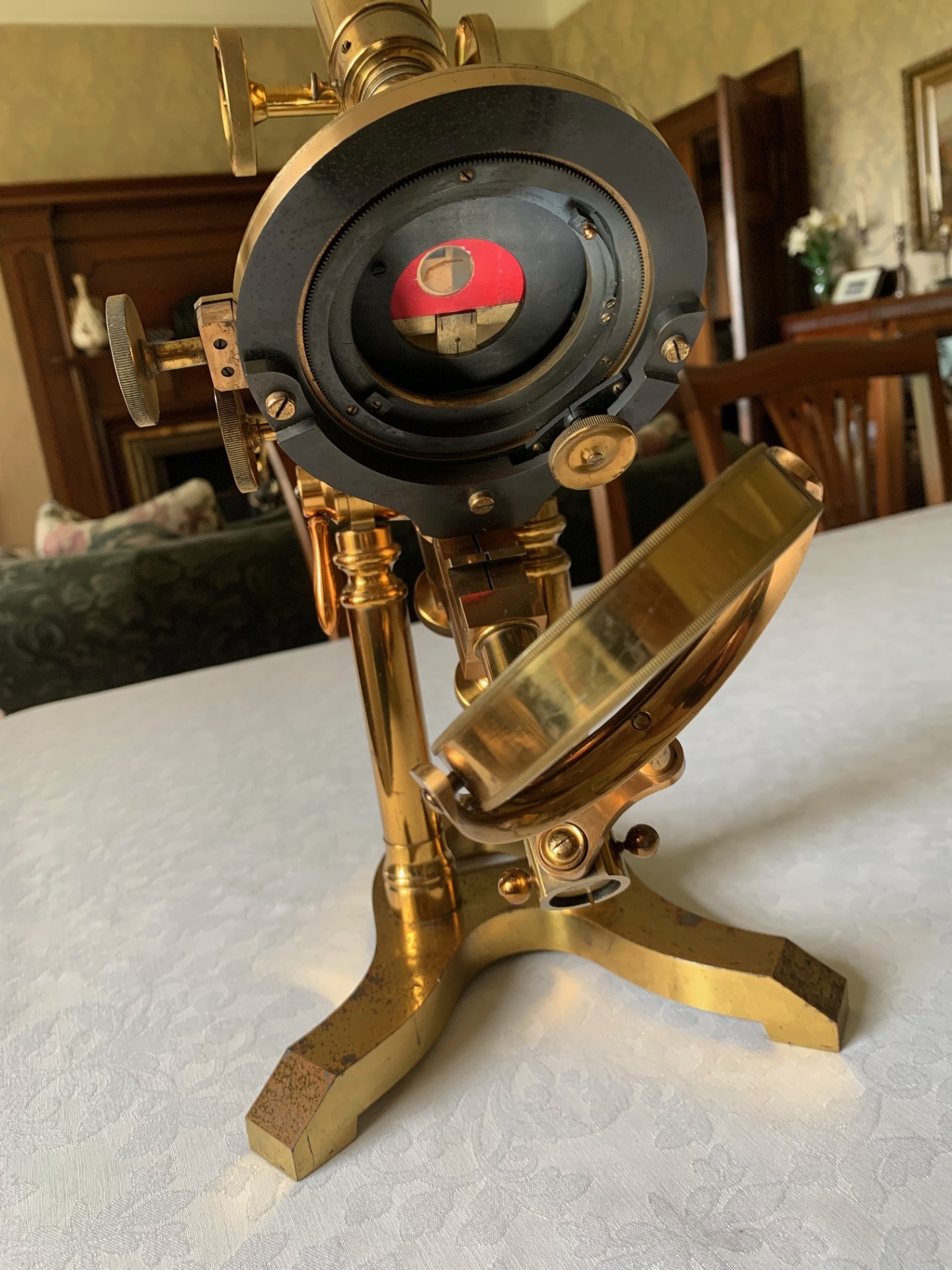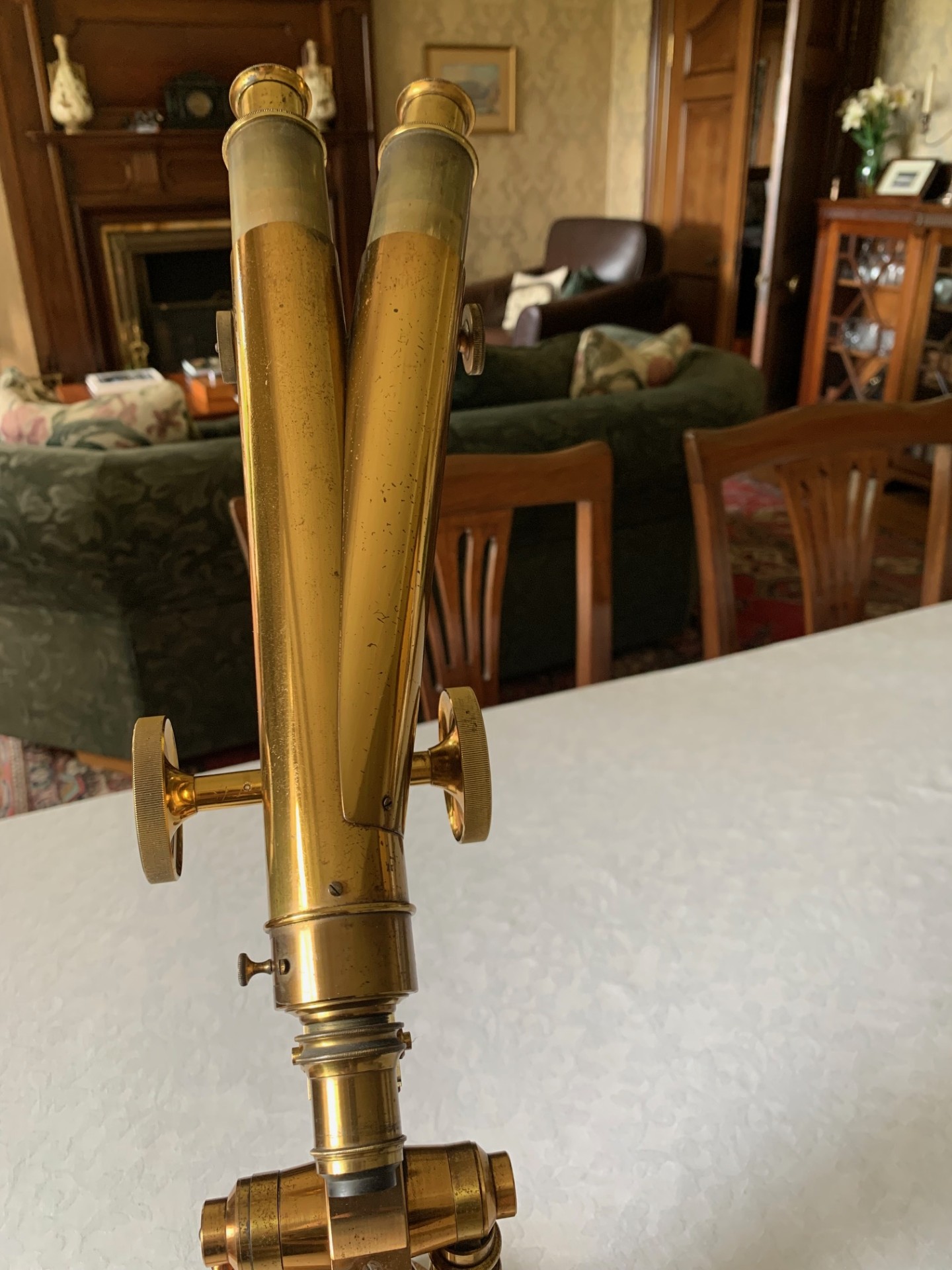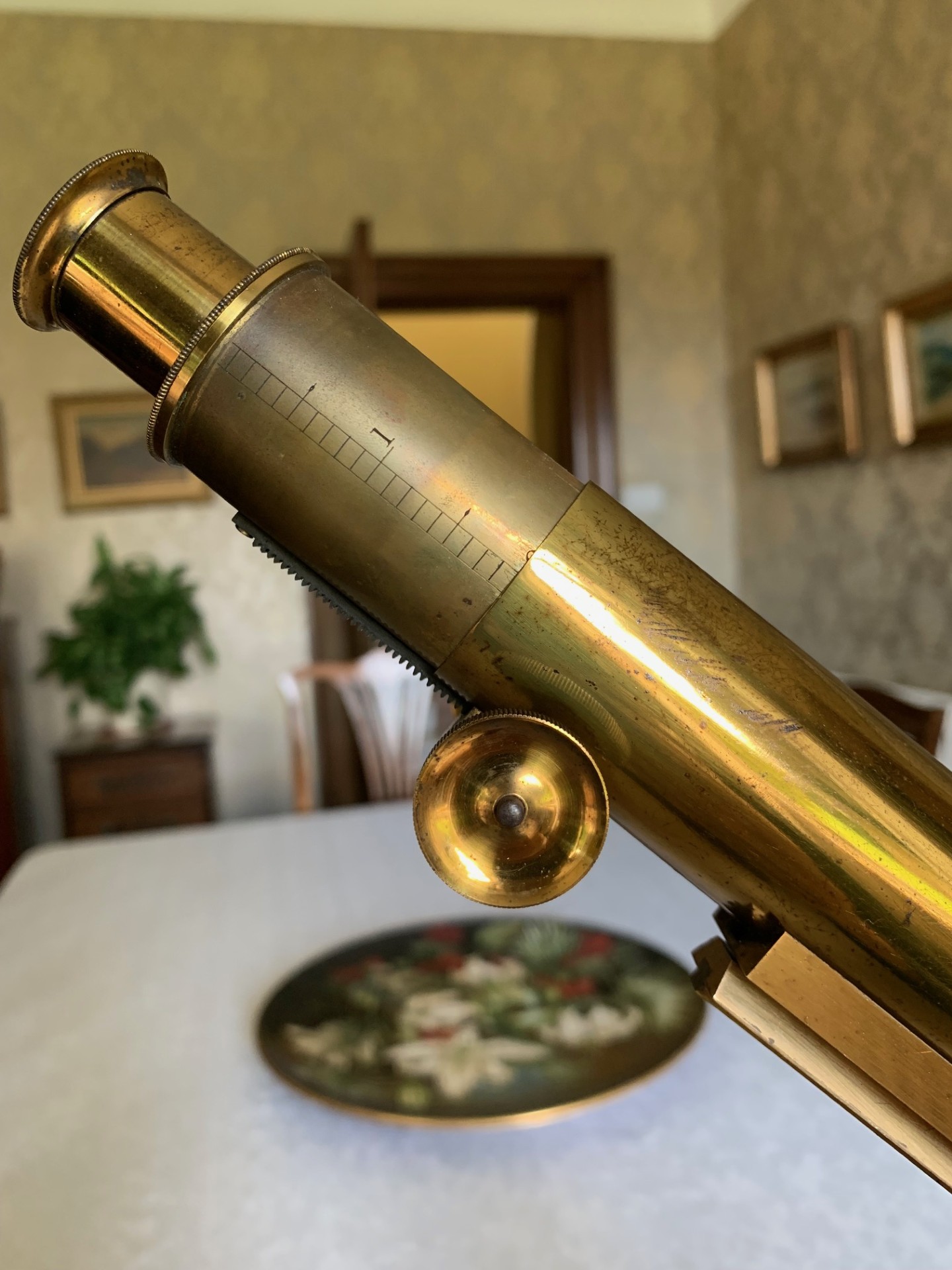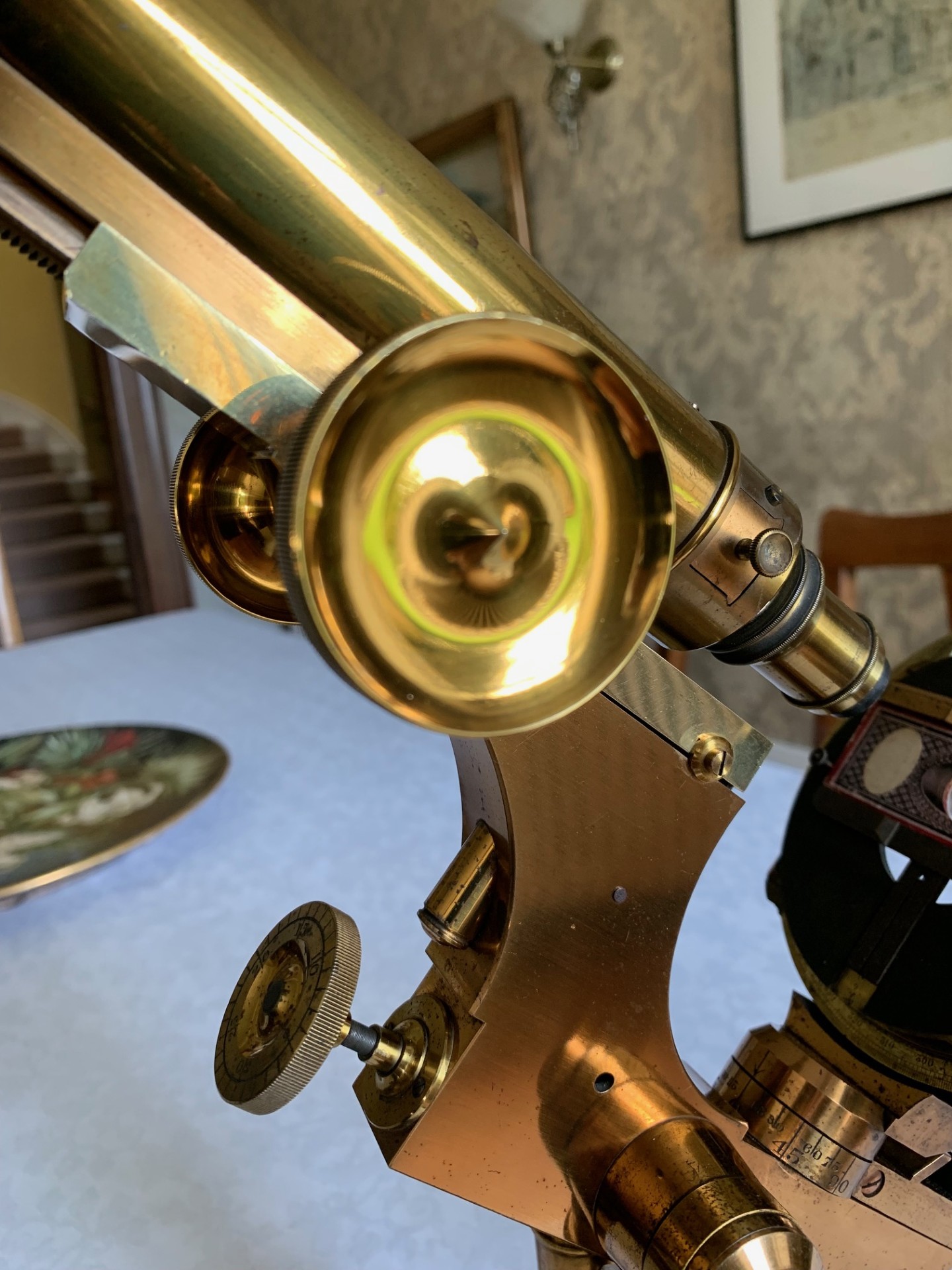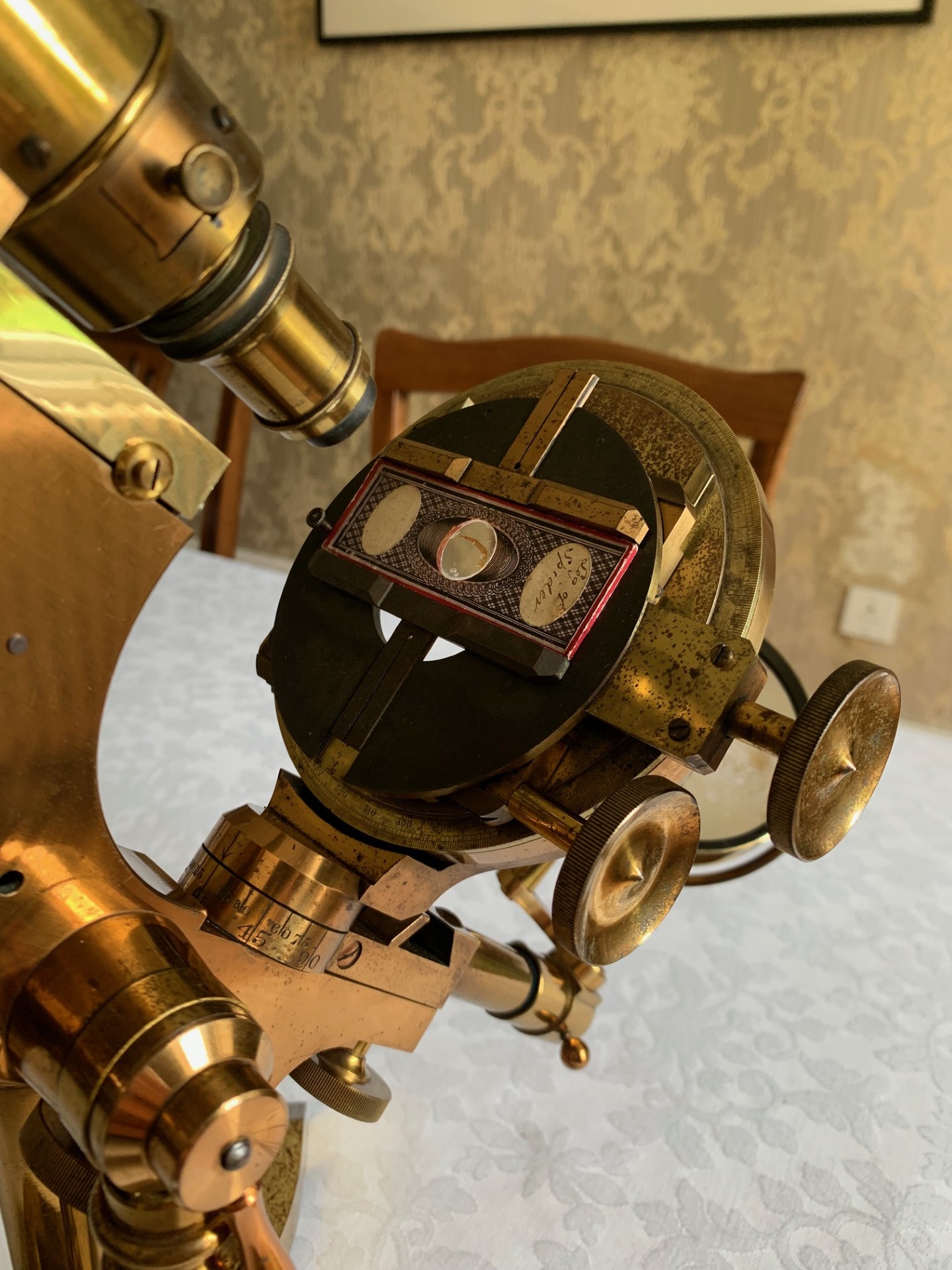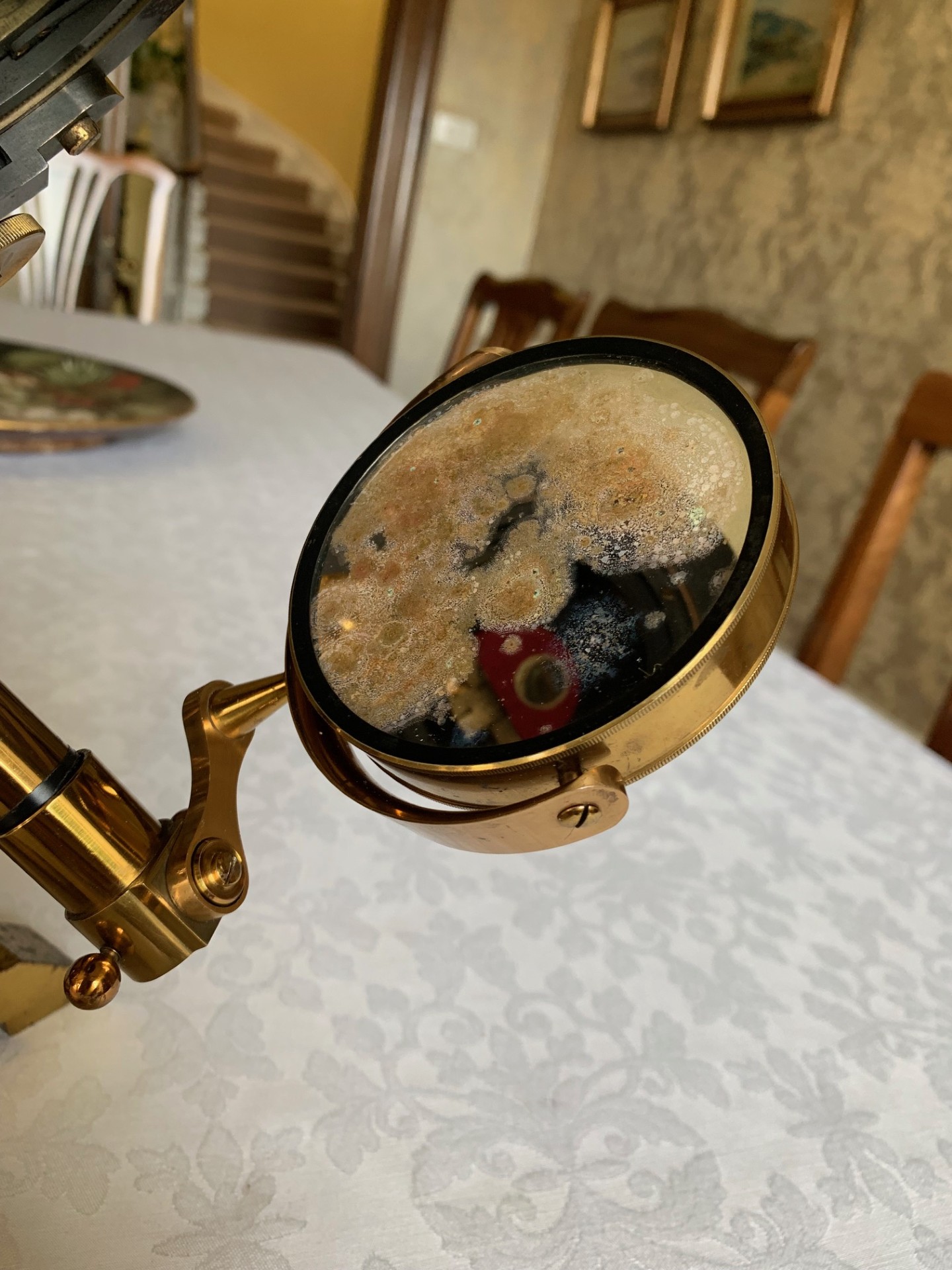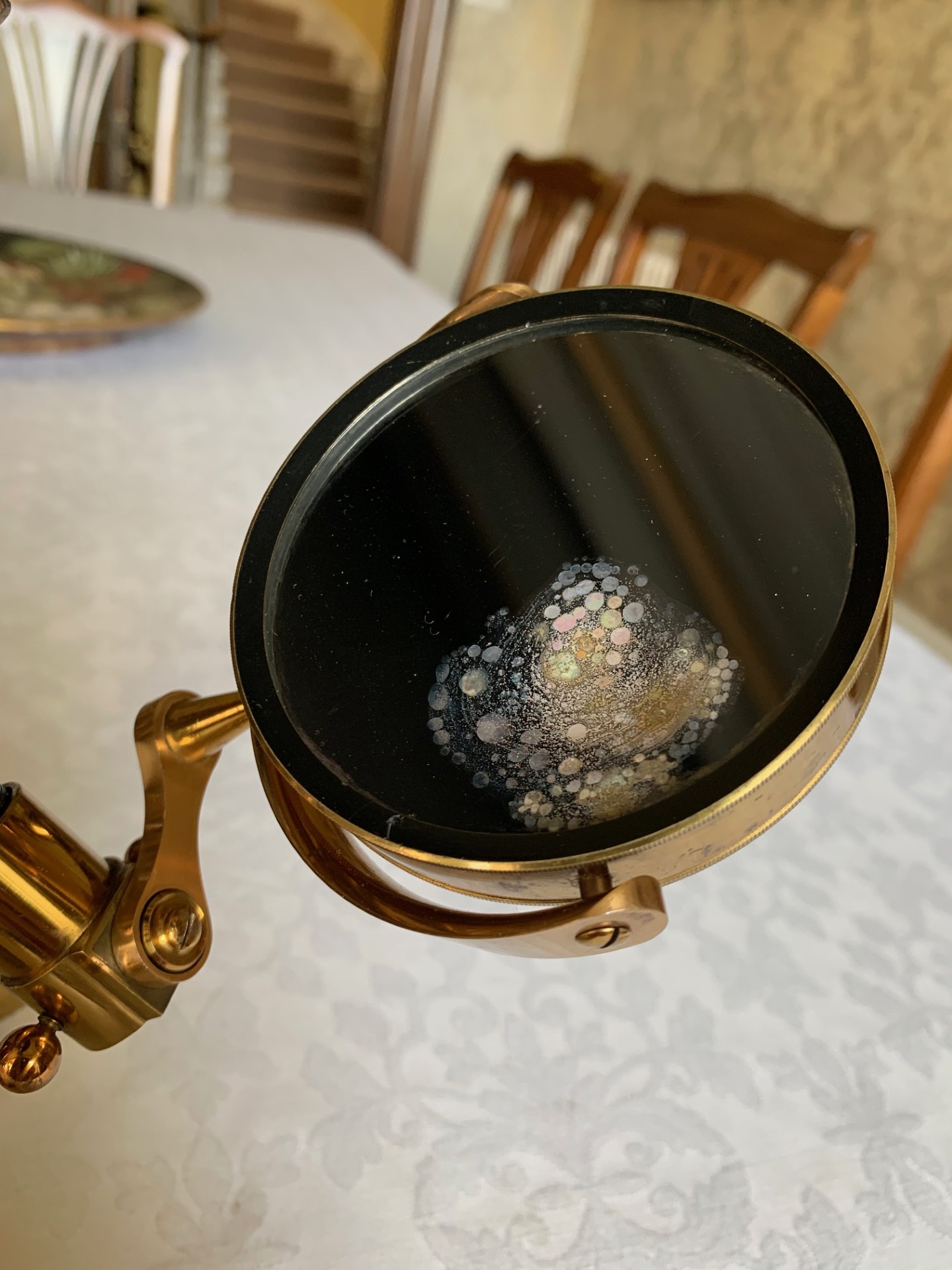SOLD – Antique Ross-Zentmayer No. 1 Binocular Microscope in Brass by Ross London c1885
Sold
Stunning and imposing antique Ross-Zentmayer binocular instrument with immense proportions by quality scientific instrument makers Ross of London - dating to around 1885. Really good cosmetic example of a Ross-Zentmayer No. 1 with Wenham binocular tubes and the swinging sub-stage feature. Note: fine focus action requires attention/repair, so please read the listing in full if you're interested in this lovely antique instrument.
Circa
1885
Maker
Andrew Ross & Co., London
Country of manufacture
UK and Ireland
Description
– Jackson-Lister type limb design
– Wenham binocular with mechanical draw-tubes
– RMS objective fitment
– diagonal-cut coarse focus rack
– vernier screw/long lever fine focus – note: this action needs attention/repair
– rotating mechanical stage with x/y controls to RHS
– swinging sub-stage for oblique illumination
– sub-stage dovetail recess for technical sub-stage fittings
– large 3 inch plano-concave reflector with tarnishing mainly to plane side
Background to Andrew Ross & Co.
Andrew Ross founded his business in 1830 and, like James Smith, later of Smith & Beck, he collaborated with J.J. Lister, the manufacturing optician who invented a mathematical method of producing objectives which were both achromatic and aplanatic. Ross’s early instruments were constructed initially in a fashion similar to other contemporary makers, including a construction style similar to that of the Lister-limb design. He continued this practice until 1840 when he developed the “bar-limb”, a very stable design and from then on also supported his stands on the classic Y-shaped foot with two upright supports. Early examples of the Ross bar-limb construction used a triangular bar, which was later replaced by a square one and finally on the largest and heaviest version, a rectangular one. The Ross bar-limb design became the standard for many British microscope makers throughout the second half of the 19th century. Some conservative companies such as Powell and Lealand continued the manufacture of bar-limb microscopes into the 20th century, long after improved continental designs appeared in the market. Andrew Ross died in 1859 and his son Thomas Ross carried on the business. Thomas Ross died about 1870 and the management of the firm was taken over by famous inventor Francis Wenham who was responsible for the development of the Ross-Zentmayer models in the 1880s and these remained in production into the 1890s until replaced by continental designs. The Ross company went on to produce optical products well into the twentieth century, although large high-quality microscopes became less important to the firm as the years went by. The firm was called Ross & Co between 1837 and 1841, then Andrew Ross & Co and finally Ross Limited from 1897 onwards. The firm discontinued the production of microscopes in 1906. (Source: ‘Antique Microscopes’ website)
This example of a Ross binocular microscope presents really well with lovely gleaming brass-work details and some age-appropriate patination here and there mainly to the foot, although nothing detracts from the visual appeal, which is what you’d hope for with an antique instrument of this age. The instrument’s look and feel is of a quality not found in modern microscopes in that’s it’s fashioned from solid brass, giving it a really heavy feel and it’s also quite a large instrument at around 20 inches in height when extended and inclined for use, rising to over 24 inches when positioned vertically.
Technical details – the construction is a brass A-shaped foot (also sometimes referred to as a Lyre-shaped foot) with large twin uprights supporting a pivot and a Jackson-Lister upper limb arrangement. The coarse focus is by rack and pinion with the newer-style helical/diagonal cut that features on instruments from the 1880s onwards and there’s plenty of travel, so I know that even a 4 inch objective will achieve sharp focus. The coarse focus has a smooth action and holds in position as it should in its working range and there’s tension adjustment available to the pinion gear as required. Fine focus is operated via a graduated brass thumb-wheel located at the rear of the main tube on the limb, being a vernier screw acting on a lever against sprung resistance. This mechanism is loose and I’ve tried to tighten and believe it will need some attention/maintenance to fully restore its functionality.
In terms of its optics, this microscope has a Wenham double optical tube with mechanically operated graduated draw-tubes with nice smooth action. The Wenham prism is present in its carrier in clean condition, rendering good usable images to both eyepieces. It’s supplied with a pair of 8x magnification top-hat B eyepieces that with correct illumination produce bright age-appropriate images. It’s currently got a 1.5 inch unbranded objective – as such this instrument is essentially currently set up for low-power entomology work and the like. With the objective fitting being RMS, there are plenty of other objectives by Ross and other makers that should also fit.
I’ve tested the optics with numerous antique slides of insect and other similar specimens and the images are perfectly acceptable when using good illumination – in fact this is one of the best Wenham binocular set-ups that I’ve known, with nice sharp bright images in both eyepieces. The magnification available with the instrument with its current set of optics will be around 32x.
The instrument tilts for inclined viewing and holds in position as it should on inclination and can be tightened via a limb-tension lever to the right hand side of the pivot. The all-brass specimen stage is fully mechanical with in addition a mechanically operated rotation feature. The x/y adjustment thumb-wheels are on the right-hand side, giving about 1 inch of travel in the x/y planes, with the rotation control below stage. All the mechanical controls work very well and hold position on inclination, with rotation well damped – there’s also a 360 degree scale on the outer edge of the stage. The stage top-plate has a rest for holding slides and two dovetail sliders that can be adjusted to hold the slide firmly in place, both moving freely.
Turning to the sub-stage, the first thing to note is that this instrument has a swinging sub-stage and a degree scale for setting the sub-stage angle. Swinging sub-stages were a development introduced in the 1880s to assist with inter alia oblique specimen lighting and although popular at the time, this feature was largely phased out by the 1890s once better Abbe-type condensers became more widely available. Sub-stage on the tail-piece we have a dovetail recess where Ross-Zentmayer specific sub-stage accessories can be located – such as various types of condensers, wheel-of-stops or polarising hardware. Lighting is via an over-size plano-concave 3 inch diameter mirror in a brass gimbal mount with swing, rotation and height adjustment, with tarnished silvering to both sides and reflectivity that’s still perfectly adequate.
The instrument has been very gently dusted and also lightly lubricated with non-hardening grease where appropriate, so that the controls operate smoothly. This example displays exceptionally well having a substantial presence and some lovely brass-work with rich gold and copper tones which catch the light beautifully. This antique microscope is very much a usable proposition and would naturally benefit from additional Ross RMS objectives and sub-stage accessories could also be added to assist with higher-power or more specialised work, especially once the fine focus has been overhauled. It will no doubt make a stunning antique display piece as is, perhaps in a library or home office type of setting, especially when set up with an appropriate antique slide. There’s also no case with the instrument at the present time. I’ve added a photo to the listing showing the instrument set up for use on a coffee table next to a large Watson Van Heurck variant metallurgical microscope which is a large instrument of similar overall dimensions.
Owing to the weight and delicacy of this antique microscope, it will be partially dismantled, carefully wrapped for shipping and dispatched by insured courier upon receipt of cleared funds.
Thanks for looking.
Ask the Dealer
Dealer information
 Arcboutant Scientific
Arcboutant Scientific
Arcboutant Scientific based in Glasgow Scotland, with an interest in scientific collectables dating back to 1988. Now making available carefully curated fine examples, principally of antique microscopes and associated scientific equipment by quality English and Continental makers, to collectors world-wide.



